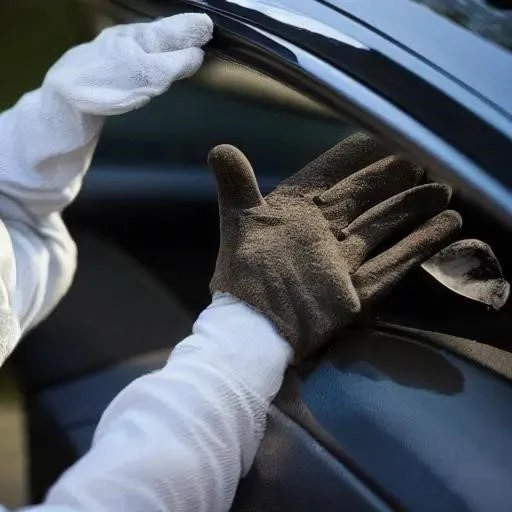
Few automotive nuisances evoke as much dread as the sight of stubborn tree sap clinging to your vehicle’s pristine paintwork. That glistening, sticky residue, often a cruel memento from a picturesque parking spot, isn’t just an eyesore; it’s a potential paint predator. For countless car owners, the challenge lies not merely in removing this tenacious natural adhesive, but in achieving its complete eradication without inflicting irreversible damage upon their beloved automobile’s delicate finish. This pervasive dilemma calls for a nuanced approach, blending both scientific understanding and practical precision to safeguard your investment.
The good news, however, is that conquering this sticky adversary is entirely achievable with the right knowledge and tools. Gone are the days of resorting to abrasive scrubbing or harsh chemicals that strip away protective layers, leaving behind dull patches or swirl marks. Today, a wealth of innovative solutions and time-tested methodologies empower drivers to tackle even the most entrenched sap deposits with confidence. By integrating insights from leading automotive detailers and material scientists, we can meticulously chart a course for safe, incredibly effective tree sap removal, preserving your car’s showroom shine for years to come. This isn’t just about cleaning; it’s about intelligent vehicle preservation.
Essential Tree Sap Removal Methods: A Quick Reference Guide
| Removal Method | Description & Key Benefits | Important Considerations & Cautions |
|---|---|---|
| Isopropyl Alcohol (Rubbing Alcohol) | A common household item, remarkably effective on fresh, softer sap. It acts as a solvent, gently dissolving the sticky residue without aggressively attacking the paint’s clear coat when used correctly. | Always dilute slightly (e.g., 70% alcohol), apply to a microfiber cloth, not directly to paint. Test on an inconspicuous area first. Avoid prolonged contact with rubber or plastic trim, as it can cause drying. |
| Mineral Spirits / Naphtha | More potent solvents for older, hardened sap that lighter agents can’t budge. These can break down the complex hydrocarbons in sap more aggressively. | Use sparingly and with extreme caution. Apply to a clean microfiber cloth, gently dab, and rinse immediately. Never let it sit on the paint. Thoroughly re-wash the area and reapply wax/sealant. Strong fumes require good ventilation. |
| Dedicated Commercial Sap Removers | Specially formulated products designed for automotive paint. Many contain a blend of mild solvents and lubricants to safely lift sap while conditioning the paint. | Follow manufacturer’s instructions precisely. While generally safer, testing on a hidden spot is always prudent. These products often simplify the process by being less aggressive than pure solvents. |
| Automotive Clay Bar | Not a primary sap remover, but excellent for removing any residual, embedded sap particles or stains after initial solvent treatment. It lifts contaminants from the paint surface. | Always use with a dedicated clay lubricant. Never use a dry clay bar. It’s a finishing step to ensure a perfectly smooth, contaminant-free surface, preparing the paint for waxing or sealing. |
| General Best Practice: Always work on a cool surface, in the shade. Test any product on an inconspicuous area first. After removal, thoroughly wash the car and apply a fresh coat of wax or sealant to protect the paint. | ||
Understanding the Enemy: Why Sap is Such a Threat
To truly defeat tree sap, one must first understand its nature. This sticky substance, secreted by trees to protect themselves from insects and fungi, comprises sugars, resins, and various organic compounds. When exposed to sunlight and air, it hardens, bonding fiercely to your car’s clear coat. Over time, particularly when subjected to UV radiation, this organic material can actually etch into the paint, creating permanent blemishes. “It’s a race against time,” explains detailing veteran Mark Johnson of Pristine Auto Solutions. “The longer sap sits, the more aggressively it bonds and the harder it becomes to remove without causing secondary issues.”
The Arsenal of Safe Removal: Precision and Patience
Fortunately, the automotive care industry has developed a sophisticated arsenal against this arboreal assault. The key lies in selecting the right solvent for the job, applied with deliberate gentleness. For fresh sap, many experts advocate for isopropyl alcohol (rubbing alcohol), typically found in concentrations around 70%. Applied with a soft microfiber cloth, it gently dissolves the sugar-based components of sap. However, caution is paramount; prolonged contact can dry out surrounding rubber and plastic trim. “Think of it as a precision strike,” advises chemical engineer Dr. Eleanor Vance, who consults for a leading car care brand. “You want to target the sap, not the entire panel, and always follow up with a thorough rinse and re-wax.”
For more stubborn, aged sap, stronger solvents like mineral spirits or naphtha may be necessary. These petroleum-based distillates are incredibly effective at breaking down the tougher resin components. Yet, their potency demands an even higher degree of care. Always test a small, inconspicuous area first to ensure paint compatibility. Apply a small amount to a clean, soft cloth, gently dab the sap spot, and immediately wipe clean with a separate damp cloth. The golden rule, universally echoed by professionals, is never to rub aggressively, which risks grinding the sap’s abrasive particles into the paint, causing scratches.
Beyond household solutions, a myriad of commercial sap removers are available, specifically formulated for automotive finishes. Brands like Meguiar’s, Chemical Guys, and Griot’s Garage offer products engineered to safely dissolve sap without harming the clear coat. These often contain a balanced blend of solvents and lubricants, minimizing the risk of damage. By integrating insights from their advanced R&D, these products frequently provide a user-friendly and highly effective solution for most car owners.
The Finishing Touch: Clay Bar and Protection
Even after the visible sap is gone, microscopic residues might remain, leaving the paint feeling rough. This is where the automotive clay bar becomes an invaluable tool. Gliding across the lubricated surface, the clay gently lifts embedded contaminants, including any lingering sap particles, leaving behind an incredibly smooth, glass-like finish. This crucial step, often overlooked by amateurs, prepares the paint perfectly for its final protective layer. After ensuring all sap and residues are eliminated, a fresh coat of high-quality wax or synthetic sealant is indispensable. This not only restores the paint’s luster but also provides a sacrificial barrier, making future sap removal significantly easier and protecting against environmental aggressors.
Proactive Preservation: Your First Line of Defense
Ultimately, the best defense against tree sap is a proactive offense. Thoughtful parking choices, particularly avoiding direct exposure under sap-producing trees, can dramatically reduce incidence. For those without sheltered parking, a breathable car cover offers an excellent shield. Regular washing and waxing also play a pivotal role. A well-maintained protective layer of wax or sealant acts as a barrier, preventing sap from bonding directly with the paint. “Think of your car’s finish as its skin,” Mark Johnson often says. “You wouldn’t expose your skin to harsh elements without protection, and your car deserves the same care. A robust wax isn’t just for shine; it’s its first line of defense.”
